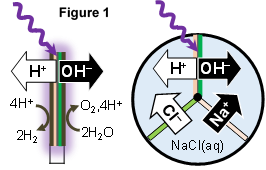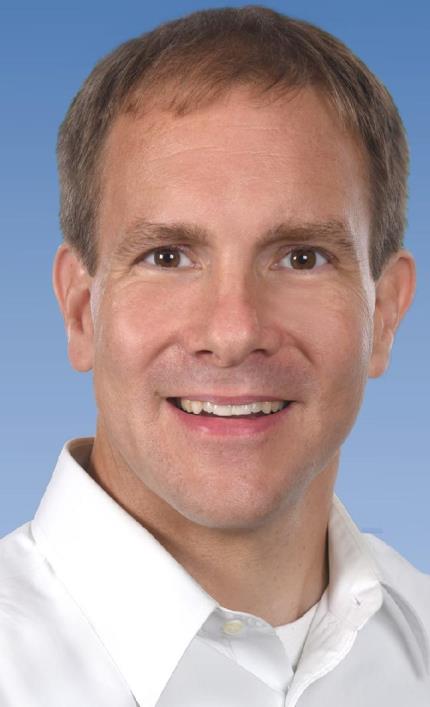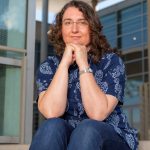About the Seminar
Protonic (H+) processes that occur in water in the dark are identical to electronic (e–) processes that occur in semiconductors in the dark; for this reason, my team defines water as a protonic semiconductor. Using this fact, over a half-century ago Prof. John Bockris demonstrated that hydrated bipolar ion-selective membranes can form ionic diodes. Recently, my team coupled this discovery with photoacid dye sensitization to demonstrate photo-iono-chemical energy conversion and photovoltages in excess of 100 mV.1,3,4 We observed that this photo-iono-chemical phenomenon is general in that covalent modification of several polymer scaffolds with several photoacid dye molecules each resulted in a photovoltaic response,1,5 and have since extended this work to ionic diodes based on doped ice cubes. The photo-responsive polymers form a new class of functional materials that upon optical excitation result in changes in ion concentrations and electrostatic potentials, which we plan to use to drive redox reactions and desalination (Figure 1), as well as biological cellular events. In addition and by analogy to Marcus electron-transfer theory, these studies have led us to a clear understanding of the driving-force dependence on the rate constants for proton-transfer reactions, as well as a better understanding of the challenges and solutions to efficient generation of clean water. This fundamental knowledge has enabled us to demonstrate the following:
- Photoacidity in several classes of proposed photoacid and photobase molecules previously thought to be thermodynamically incapable of performing excited-state proton transfer,6
- Enhance rates of proton-coupled electron-transfer reactions,
- Enhanced rates of water dissociation in bipolar membranes,7
- Electrochemical ratchets, where by application of AC electric biases across porous salt-water-permeated capacitors, directional DC ion pumping is observed,8 and
- Energy recycling via heat transport for more effective solar thermal distillation.9

References
- Ardo, W. White, …, PCT International Patent Application, 2018, US20180065095 A1, China, Germany, Japan, US.
- Ardo, D. Fernandez Rivas, M. Modestino, V. Schulze Greiving, … (45 total co-authors), Energy & Environmental Science, 2018, 11, 2768, DOI: 10.1039/c7ee03639f.
- White, C. D. Sanborn, R. S. Reiter, D. M. Fabian & S Ardo, … S Ardo, Journal of the American Chemical Society, 2017, 139, 11726, DOI: 10.1021/jacs.7b00974.
- White, C. D. Sanborn, D. M. Fabian & S Ardo, Joule, 2018, 2, 94, DOI: 10.1016/j.joule.2017.10.015.
- White, S. Luo, R. Bhide, C. D. Sanborn, M. S. Baranov, K. M. Solntsev & S Ardo, Proceedings of SPIE, 2019, 11084, 110840E, DOI: 10.1117/12.2529900.
- Ardo, R. Bhide, …, Provisional Patent Application, 2019, UC Case Number 2020-319-1.
- Ardo, W. White, …, Provisional Patent Application, 2019, UC Case Number 2019-680-1.
- Ardo, G. Segev, …, Provisional Patent Application, 2019, UC Case Number 2019-927-1.
- Ardo, J. M. Cardon, …, Provisional Patent Application, 2019, UC Case Number 2020-320-1.
About the Speaker
Shane obtained a B.S. Degree in Mathematics, with a minor in Computer Programming, from Towson University and subsequently worked as a software engineer, community college instructor, high school teacher, and tried out for a professional indoor soccer team, prior to attending graduate school. Shane obtained an M.S. Degree in Nutrition from the University of Maryland, College Park followed by M.A. and Ph.D. Degrees in Photo-Physical Inorganic Chemistry from the Johns Hopkins University, where he worked for Prof. Jerry Meyer. He then worked for Prof. Nate Lewis as a DOE–EERE Postdoctoral Research Awardee at the California Institute of Technology until 2013. Since that time, Shane has been an Assistant Professor (2013 – 2019) and now an Associate Professor at the University of California, Irvine in the Department of Chemistry and holds courtesy joint appointments in the Departments of Chemical & Biomolecular Engineering and Materials Science & Engineering. His group studies Photo…Chemistry, with the aim to understand and control the kinetics and mechanisms of reactions at interfaces. They do this by designing, synthesizing, characterizing, and modeling asymmetric molecule–material structures for practical applications in desalination, atmospheric water harvesting, solar fuels devices, photovoltaics, fuel cells, electrolyzers, and redox flow batteries. In 2016, Shane was named one of five inaugural Moore Inventor Fellows. He is also a recipient of a DOE Early Career Research Award and a Beall Innovation Award, and was named a Sloan Research Fellow, a Cottrell Scholar, a Kavli Fellow, and a Scialog Fellow. Shane has given over 100 invited talks, including at the National Academy of Sciences Distinctive Voices Lecture Series, the 2017 Resnick Institute Young Investigators Symposium, and Apple’s Membrane R&D Division. His research group is also supported by funding from the U.S. Department of Energy’s Office of Energy Efficiency and Renewable Energy, the U.S. National Science Foundation’s Chemical Catalysis Program, Nissan Chemical Corporation, and collaborative projects funded by University of California MEXUS–CONACYT, Research Corporation for Science Advancement, and UC Irvine’s Research Seed Funding Program. His research group is also part of the recently announced DOE Energy–Water Desalination Hub.



